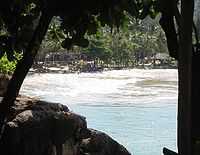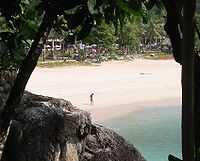Effect of the 2004 Indian Ocean earthquake on Thailand
The Thai government reported 4,812[1] confirmed deaths, 8,457[1] injuries, and 4,499[1] missing after the country was hit by a tsunami caused by the Indian Ocean earthquake on 26 December 2004. The Thai authorities estimate that at least 8,150 are likely to have died. The popular tourist resort of Phuket was badly hit. The smaller but increasingly popular resort area of Khao Lak some 80 km north of Phuket was hit far worse with 3,950 confirmed deaths, however, the death toll in Khao Lak may have exceeded 4,500. The severity of the situation in Khao Lak is probably explained by the fact, that unlike the high-rise hotels of Phuket, the village of Khao Lak only had low built bungalows instead of high-rise concrete hotels. There was no warning of the first wave so people had no idea it was coming. These days, Thailand is better prepared for tsunamis as they are 3 hours away from being hit again if there is a new tsunami.
Khao Lak also has an extensive area of flatland only a few meters above the sea level, on which most bungalows were situated. Hundreds of holiday bungalows on the Phi Phi Islands were washed out to sea. Tuk-tuk drivers were quick to offer assistance, driving victims to hospitals, higher grounds and away from the surging waters. Bhumi Jensen, grandson of HM King Bhumibol Adulyadej, was among those killed. The nearby Ko Lanta Yai, however, wasn't afflicted as badly. At some places in Phuket and Phang Nga provinces, elephants were used to move and lift heavy wreckage to search for victims and to clear roads. These included six male Indian elephants which had previously been used in making the movie Alexander. On a beach in Thailand, a man was leading an elephant to entertain tourists, when the tsunami came. The elephant's natural instinct to flee the sea saved the life of a young girl who was upon his back.
| Official figures as of 7 January 2005 | |||||||
|---|---|---|---|---|---|---|---|
| Province | Thai deaths | Foreign deaths | Total deaths | Thai injured | Foreign injured | Total injured | Missing |
| Krabi | 288 | 188 | 476 | 808 | 568 | 1,376 | 890 |
| Phang Nga | 1,950 | 2,213 | 4,163 | 4,344 | 1,253 | 5,597 | 2,113 |
| Phuket | 154 | 105 | 259 | 591 | 520 | 1,111 | 700 |
| Ranong | 167 | 2 | 169 | 215 | 31 | 246 | 12 |
| Satun | 6 | 0 | 6 | 15 | 0 | 15 | 0 |
| Trang | 3 | 2 | 5 | 92 | 20 | 112 | 1 |
| Total | 2,568 | 2,510 | 5,078 | 6,065 | 2,392 | 8,457 | 3,716 |
Source: Bangkok Post. The "total deaths" and "total injured" categories include dead and injured persons whose nationality is not given or has not been established. The number of "foreign injured" has been reduced by evacuations of foreign nationals. Thai sources acknowledge that the great majority of those listed as "missing" are in fact dead, and that a large majority of these are foreigners.
An article in the Bangkok Post on 10 January suggested that some of the figures in this table may be seriously misleading. According to this article, the estimated number of deaths among Thai nationals has been reduced from about 2,500 to about 1,800, and the estimated number of deaths among foreigners has been reduced from 2,500 to 1,300. The number of deaths whose nationality has not been established has risen correspondingly, from less than 200 to about 2,100. This is due to increasing doubts about the reliability of the classification on the basis of visual identification of badly decomposed bodies into "Thai" and "foreign" categories. All bodies of unknown origin will now be DNA tested to determine their ethnic origin.
Impact



The economic impact of the tsunami on Thailand was considerable, though not as great as in poorer countries such as Indonesia or Sri Lanka. Thailand of mild econism has a liberalised, flexible and robust economy, which has shown powers of rapid recuperation after previous setbacks. The sectors most badly damaged have been tourism and fishing. The beach resorts along the Andaman Sea coast have been extensively damaged. Many Thai-owned hotels and other small businesses have been ruined, and the Thai government provided large amounts of capital to enable the recovery of the private sector.
Infrastructure in general was, predictably, severely damaged, though much has been gleaned from surveying the aftermath. Reinforced concrete power poles are normally the standard in countries with high seismic risk. Addition of the tsunami's waves and associated debris demonstrated their weakness to shearing at the base. There were revelations about the height of these poles, too - the (up to) 10 meter waves submerged the shorter, older poles. And high-density polyethylene piping was found to perform exceptionally well: as roads crumbled, the subterranean flexible pipelines formed new contours and rarely separated.[2]
The confidence of European tourists in travelling to places such as Phuket also took some time to recover, which is one reason why Thailand has strongly backed the installed tsunami warning system. Thousands of Thais dependent on tourism-related industries have lost their jobs, not just in the south but also in the poorest part of Thailand, Isan in the north-east, where many workers in the tourism industry come from. By 12 January some of the affected resorts in the south had re-opened, and the Thai government had begun an advertising campaign to bring visitors back to the area as quickly as possible, though everyone knew it would be quite a while before Thailand was in a state of normalcy, professionals guessed around ten years.
The fishing industry has been damaged by the extensive destruction of fishing boats and tackle, which individual fishing families couldn't afford to replace, particularly since many have lost their homes as well. According to one report, more than 500 fishing boats and ten trawlers have been destroyed, as well as many piers, boatsheds and fish-processing facilities. Again, grants or loans from the government have been essential to enable the industry to re-equip itself.
A further problem was the public aversion in Thailand to eating locally caught fish, for fear that the fish have fed on human dead bodies which were swept out to sea by the tsunami. Thais found this possibility offensive both on health grounds and for religious reasons. Fish product distributors refused to buy fish and crustaceans from Andaman Sea ports, and preferred to buy from Gulf of Thailand ports or even from Malaysia or Vietnam, so that they could assure consumers that there was no possibility of such contamination. As a result, even those fishing families who were able to fish were unable to sell their catch. The Director-General of the World Health Organisation, Dr Lee Jong-Wook, went on Thai television to say that he was eating fish every day.
In the long run the tsunami disaster has brought considerable benefits to Thailand, especially the southern tourist areas. European governments have pledged large sums of money to rebuild infrastructure and to fund new schools and orphanages for the Thai communities affected, as a gesture of thanks for the assistance given to their citizens by the Thai people. The destruction of many second-rate structures along the beaches have provided opportunities to rebuild popular tourist areas such as Patong Beach at Phuket in a more aesthetically and environmentally suitable way.
Thailand held legislative elections on 6 February, and the tsunami disaster has been drawn into the election campaign. Prime Minister Thaksin Shinawatra has accused the former Democratic Party of Thailand government of Chuan Leekpai of ignoring warnings in 1998 of the possible risk of a tsunami affecting Thailand. His allegations have been supported by the former head of the Meteorological Department, Smith Tumsaroch. Democratic Party politicians said that Smith has failed to produce any evidence for his warnings at the time, and accused Thaksin of politicising the tsunami tragedy.
References
- ↑ 1.0 1.1 1.2 http://www.disaster.go.th/news01/12_47/news_after_shock_34.pdf
- ↑ Carl Strand, John Masek, ed. (2007). Sumata-Andaman Islands Earthquake and Tsunami of December 26, 2004. ISBN 9780784409510.
External links
- Photos before the destruction of Koh Phi Phi Island
- [rom Phuket at the time of the disaster]
| Regional humanitarian situation due to the 2004 Indian Ocean earthquake and tsunami |
| Burma | India | Indonesia | Malaysia | Maldives | Somalia | Sri Lanka | Thailand |